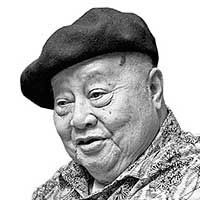Tribute to Gilda Cordero Fernando

With the passing of Gilda Cordero-Fernando last Thursday, we lost a great writer and cultural activist. She had so many qualities that ordinary writers do not have. She was also a book publisher, a fashion designer, a dramatist, a superb artist and, in a sense, a very profound critic of Filipino culture.
I first met Gilda way back in the 1950s when she was blooming with the freshness of a young writer. One of her most memorable stories which should be included in any anthology of modern Philippine prose is People in the War. It is a moving and incisive account of what it was like in Manila during the last days of the Japanese Occupation.
Gilda was city-bred, and much of her fiction was rooted in her middle-class Manila background. When I returned from Colombo, Ceylon in 1965, I set up the Solidaridad complex which included a publishing house, a quarterly journal, a bookshop, and an art gallery. The basic purpose of the gallery was to promote Philippine art and to give it a Filipino and an Asian face. It was very felicitous that Gilda suggested a folk art section in the gallery, to which I gladly concurred. In the first place, I have always believed that folk arts are the signal foundation of any people’s culture, and it can be the first phase in the development of that nation’s art. The folk art section of the gallery was very popular. Gilda and her deep interest in Philippine culture was able to sustain that gallery with artifacts from all over the country -- the weaving, basketry and woodworks from the Cordilleras, papier-mache and handicrafts from the provinces, samples of creative pottery, bamboo artifacts and those brass betel nut containers from Mindanao, and weaving from that huge island as well.
At the same time, Gilda was also working with Alfredo Roces on a series of books called, The Filipino Heritage, illustrating this country’s history and culture. On the side, Gilda ventured into book publishing which then, until now, was risky business. She produced several of what is called coffee table books that depicted not only her major interest as a cultural worker but also her commentary on the country’s social classes, fashion and architecture.
I have always expected Gilda to write a novel. After all, she had two collections of short stories which indicated her creative talents as well as the depth of her understanding of the Filipino condition. Unfortunately, she never got to write that novel. Some 20 years ago, I asked her why she didn’t write it after all that bravura performance that was an introduction to something greater and longer. She said that she had found writing too difficult, and therefore, she went into painting. She held several exhibitions of her work, and for the ordinary person who wants to have a glimpse of it, all she has to do is pass by her house on Panay Avenue in Quezon City. The gate is adorned with her work.
How will one label her art? It is abstract yet not truly abstract for the forms are recognizable. She had ventured into this fantasy world of distorted faces and dreamlike forms. It is also obvious that she could draw. There is something folksy about her art, and that could very well be exquisite decorations for jeepneys.
Gilda also wrote about food, and it was always a pleasure to attend the intimate meals that she served in her house which, in itself, was very interesting because it was designed by Lindy Locsin and was influenced by Japanese architecture.
I cannot think of a single instance wherein Gilda and I disagreed. In fact, even when it came to politics, we agreed. She was very much opposed to the Marcos dictatorship, and there was a time when she participated in the demonstrations against Marcos.
In her autobiographical essays, Gilda was very candid about her feelings, her likes and dislikes. She was able to gather around her several young writers who were charmed not only by her exquisite prose but by the youthfulness of her views.
A few years back, the Ateneo de Manila University, where she studied briefly for a masters degree, honored her with one of its highest awards. Perhaps, in lieu of the MA degree that she didn’t finish, she felt that what she had already written could substitute for an MA thesis.
I wish I had the copy of her response so I could print it in full. I’m making this comment now as a writer and as an editor: it was one of the most eloquent testaments of nationhood crafted by a Filipino writer.
I nominated Gilda for the National Artist Award. Looking back and appraising her achievements and what she was as a person, I now realize that such an award is superfluous. Gilda is not only a National Artist. She is also a Filipino idol.
- Latest
- Trending





























